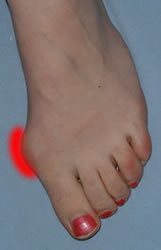Do Bunions Involve Surgery
Overview
 A bunion (from the Latin 'bunion', meaning enlargement) is a protuberance of bone around the big toe joint. The enlargement can also occur at the outside of the foot, at the base of the little toe. This is called a tailor's bunion or bunionette. As a bunion deformity progresses with time, an enlargement increases in size behind the big toe, making shoe wear difficult and painful. Consequently, the big toe will shift position and move over or under the toes next to the big toe. Bunions can occur at any age between childhood and the golden years. The occurrence of bunions are far more prominent in women than men. Ill fitting narrow shoes and shoes with heels tend to aggravate bunions and cause them to occur at a higher incidence.
A bunion (from the Latin 'bunion', meaning enlargement) is a protuberance of bone around the big toe joint. The enlargement can also occur at the outside of the foot, at the base of the little toe. This is called a tailor's bunion or bunionette. As a bunion deformity progresses with time, an enlargement increases in size behind the big toe, making shoe wear difficult and painful. Consequently, the big toe will shift position and move over or under the toes next to the big toe. Bunions can occur at any age between childhood and the golden years. The occurrence of bunions are far more prominent in women than men. Ill fitting narrow shoes and shoes with heels tend to aggravate bunions and cause them to occur at a higher incidence.
Causes
The commonest cause of bunions is prolonged wearing of poorly designed shoes such as the narrow high heels that women wear. This is one of the reasons why bunions are much more common in women than in men. There is also a hereditary component to bunions in that many times we will see a grandmother, mother and daughter all with various stages of bunions. 38% of women in the United States wear shoes that are too small and 55% of women have some degree of bunion formation. Bunions are 9 times more common in women than they are in men.
Symptoms
With an advanced bunion, the big toe joint can be significantly deformed. The big toe can crowd the other toes and may lie over or under the second toe. The larger the bunion gets, the more it hurts to walk. Wearing any type of shoe can be painful. Symptoms of bunions tend to increase over time as the condition worsens. Typical symptoms include deformity of the big toe joint. Growth of a bony lump (exostosis) at the side of the big toe joint. Pain, redness and tissue swelling (bursitis) over the big toe joint, with thickening of overlying skin. Pain when walking (particularly during the "push off" phase). Overlapping of the big toe above or below the second toe in severe cases.
Diagnosis
People with bunions may be concerned about the changing appearance of their feet, but it is usually the pain caused by the condition that leads them to consult their doctor. The doctor will evaluate any symptoms experienced and examine the affected foot for joint enlargement, tissue swelling and/or tenderness. They will also assess any risk factors for the condition and will ask about family history. An x-ray of the foot is usually recommended so that the alignment of big toe joint can be assessed. This would also allow any other conditions that may be affecting the joint, such as arthritis, to be seen.
Non Surgical Treatment
The choice of treatment for a bunion lies between non-operative (conservative) and operative treatment. Conservative treatment for a bunion means either wearing wider fitting shoes or shoes with softer leather or using some form of a spacer between the big toe and 2nd toe (or alternatively some form of splint to keep the great toe away from the 2nd toe). The spacers or splintage may apparently straighten the bunion but they make no difference to the width of the foot, and the splaying of the 1st and 2nd metatarsals which occur with a bunion deformity. Therefore this type of treatment will not improve the main pain in a bunion which occurs due to the width of the forefoot. An arch type support orthotic may be useful if a bunion is associated with a flatter foot. If you have a bunion this is however just one other thing to get into a shoe with an already wide foot. 
Surgical Treatment
If these methods fail, then surgery may be suggested. Basically, bunion surgery is performed to improve function or to prevent pain from occurring. When surgery is delayed in a symptomatic foot, greater amounts of arthritis can develop and the more complicated surgery can become. Surgery is performed to improve alignment and function to the big toe joint. The large bump is removed and, sometimes, a cut is made into the bone, to move it to a more normal position. Screws, pins and wires can be used beneath the skin, to improve healing and results. Healing can range from 3-12 weeks, depending on the procedure.
Prevention
The best protection against developing bunions is to protect and care for your feet every day. Avoid tight and narrow-fitting shoes. Limit your use of high heels. Wear comfortable shoes with adequate space between your longest toe and the end of the shoe. Getting treatment for very flat or very high-arched feet (if you are experiencing symptoms) will give your feet the proper support and help maintain stability and balance.